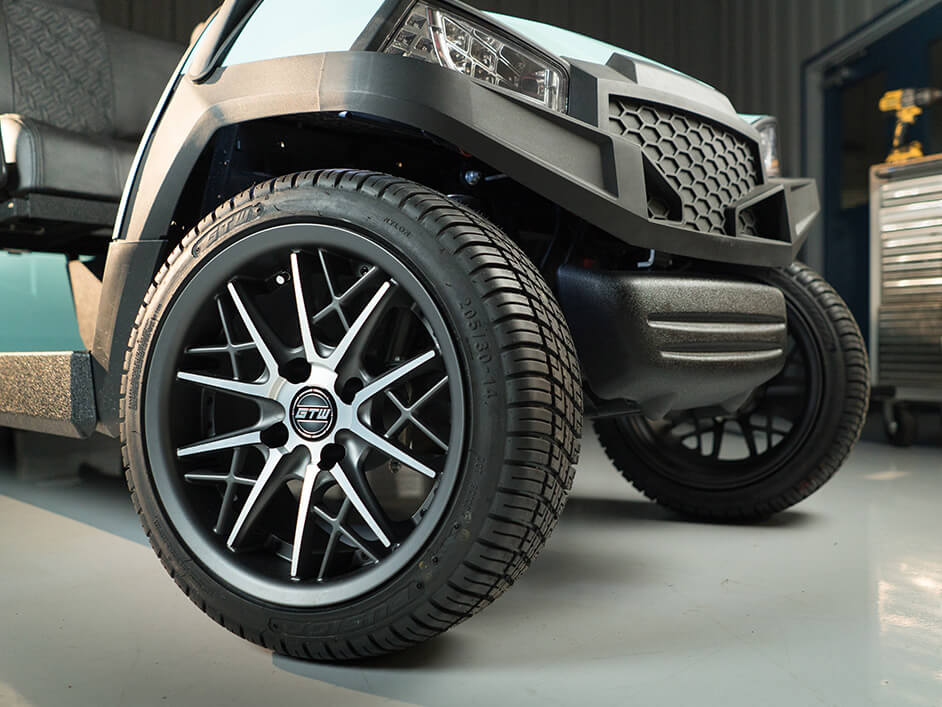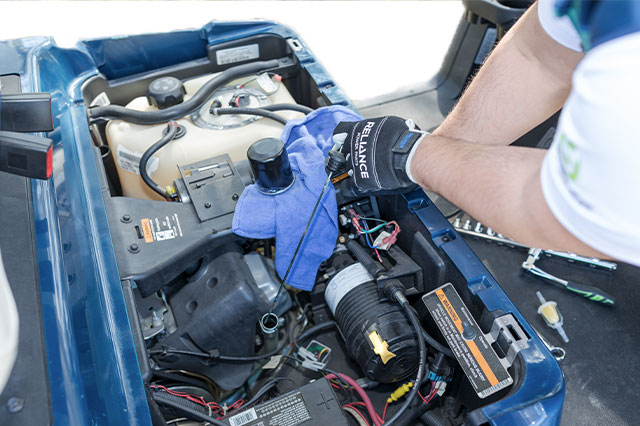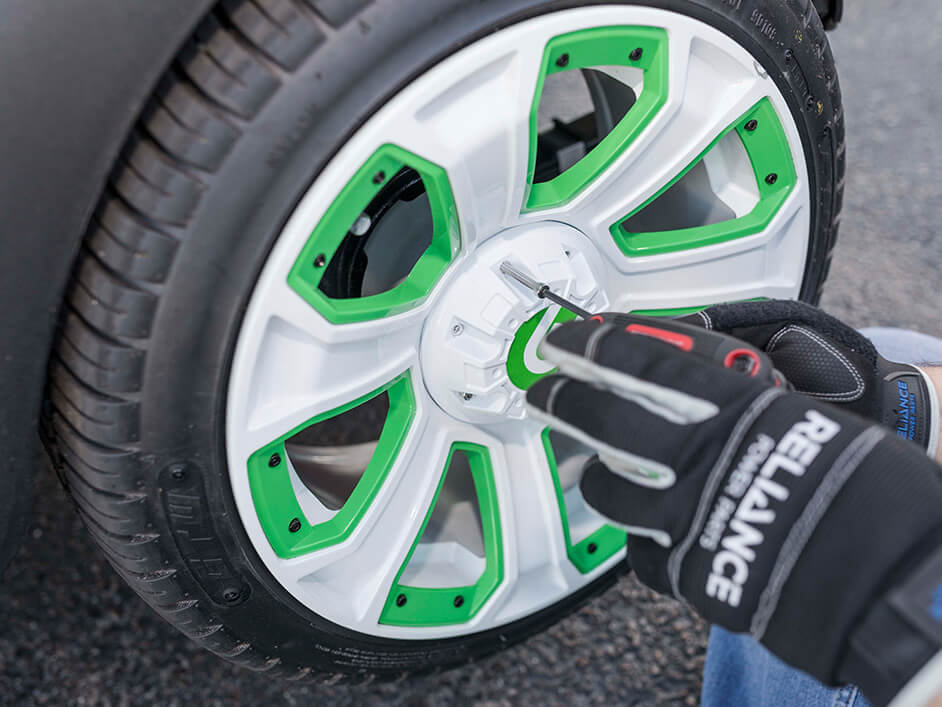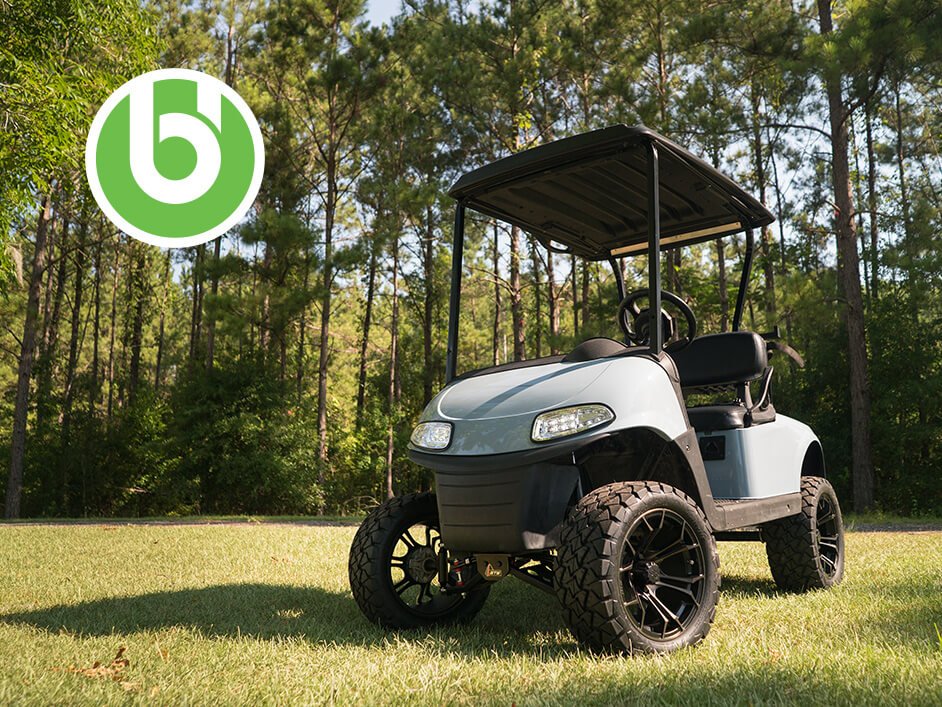OEM factory wheels are great. They’re round, they hold tires, and they let your cart move. They’re designed to work perfectly for the course and the cart path—but what if that’s not the only place you ride? What if you use your cart for something totally different?
Aftermarket wheels offer all the variety, style upgrades, and performance benefits that stock wheels don’t. They can increase your ride height, improve cornering stability, and even give your cart some well-deserved swagger.
If you don’t do the research however, the wheels you buy might end up a bust. If you’re looking into getting new wheels for your cart, it’s important to know how to measure the size, width, and offset to make sure your cart rides the way it’s supposed to.
Today, we’re going over what measurements you’ll need, how to measure them, and the benefits of different wheel styles.
Measuring your golf cart wheels
There are four measurements that can tell you virtually everything you need to know about a wheel. Once you understand these four, you’ll know what tires are best for your golf cart and what modifications you might need to make:
- Wheel height
- Wheel width
- Backspacing
- Offset
What is wheel height?
This is the diameter of the wheel minus the half inch or so that gets covered by the tire bead. The wheel height determines the tire size you need to use. Stock wheel height for Club Car, E-Z-GO, and Yamaha is usually between 8 and 8.5 inches.
But measuring isn’t usually necessary. The wheel size will be stamped on the inside of the wheel (along with offset) which is the easiest way to tell.
The kind of tire you choose for your wheel will determine the height of your car, or rather, how far it sits from the ground. Larger aftermarket wheels range up to 14 inches in height; larger wheels can improve traction and grip, and improve appearance and raking. However, you will sacrifice some acceleration and use more fuel.
What is wheel width?
With the wheel laid face-down on the ground, this is the distance from the ground to the top of the wheel (minus one half-inch, just like wheel height). Most golf cart wheels are 7 inches wide—varying a good deal less than other vehicles.
What is backspacing?
Backspacing is the distance from the inside lip of the wheel to the wheel mounting hub. So, with the front of the wheel lying on a flat surface, press a tape measure to the mounting hub, and measure where the top lip of the back of the rim sits.
Depending on the style of golf cart wheel, this can vary. When coupled with the offset of the wheel, backspacing can give a wheel different ride characteristics. Less backspacing can put more of the wheel “out” away from the car, and more backspacing “sucks in” the tires and wheels towards the chassis.
What is offset?
Wheel offset can be neutral, negative, or positive. A positive offset means there is a greater amount of backspacing, and the majority of the wheel’s width is tucked in towards the chassis. Both have their advantages and disadvantages, and make a big difference in your ride.
Positive offset benefits:
- Wheels stay tucked under fenders
- More conducive to offroad tires
- Stay closest to OEM tuning/specification
Negative offset benefits:
- Improved cornering
- Wider “stance”
- More aggressive look/options for styling
No matter what you choose, it’s important to know that the wheels you buy will work on your cart. So, understanding which brands of aftermarket golf cart wheels will fit is key.
Are golf cart wheels universal?
It would be easy if every wheel was designed for every cart, but for aftermarket parts, it’s not necessarily true (but it’s pretty close). Almost all aftermarket wheels are a universal fit, but some sizes and bolt patterns may differ from model to model. So, even though all golf cart wheels measure 7 inches wide, the bolt patterns, offset, and rim size all determine if a wheel will fit.
These measurements are listed in product descriptions, usually in this format:
Height x Width, 3:4 (offset).
Certain wheels with negative offsets might jut out and rub on fenders, and too positive of an offset could lead to the inside of your tires rubbing on the chassis or suspension.
The easiest way to upgrade your golf cart wheels is to look up the OEM factory wheels, and try to keep the offset, and backspacing near the same, and keep wheel size 12” or under. That way, you’re likely to have a great fit and enhanced ride.
The standard-sized golf cart wheels that you see every day are perfect for what they’re made for. If you are looking to upgrade style but maintain factory standard stats, stick to the standard sizes for each manufacturer.
What are standard size wheels on a golf cart?
Golf cart wheels OEM-factory and aftermarket—have a few standard sizes they conform to. The width is almost always 7”, and the height stays within what the chassis and fenders can fit with a stock ride height.
The OEM standard you’ll find on the course or on Club Car or Yamaha’s website is 8”. There are variations and upgrades up to 12” wheels, but the majority of base-models use the 8” size.
Aftermarket wheels have a good bit more variety. Although they stay around the 7” of width almost always, the sizes range up to 14”, with the standard size just being what’s most popular. We find a lot of aftermarket wheel purchases are in the 10” to 12” range.
Club Car standard wheel sizes
HEIGHT: 8” – 12”
WIDTH: 7”
Club cars are a classic in the golfing community. They’ve had a standard size of 8” for years, but have expanded their manufactured wheel selection up to 12”. Find the best wheels for your Club Car.
EZ-GO standard wheel sizes
HEIGHT: 8” – 12”
WIDTH: 7”
E-Z-GO manufactures some of the highest quality carts, and just like Club Car, they have a variety of styles to choose from in wheels. However, EZ-GO does now opt for a larger 10” as their standard size, and offers 12” wheels as well. Shop top EZ-GO Wheels here.
Can you put ATV or car wheels on a golf cart?
It sounds like a pretty simple swap: and for the most part, it is. But, the width of the ATV wheels does play a factor. Though the bolt patterns of 4X4 still match across ATVs and golf carts, we don’t advise using ATV tires on your cart. Often, the distance between the bolts on golf carts is 100. On UTVs and ATVs, that same distance is 110. This is enough to cause a problem, and forcing it is only going to cause your golf cart wheels and wheel hub damage.
What is the biggest tire you can put on a golf cart?
A standard suspension for a golf cart can accommodate up to 18 inch tires, so the wheels must be less than 12 inches to fit without any other modifications. If you want to enhance the look and traction of your golf cart with a negative offset, 14-inch set of wheels, a lift kit can give you the clearance you need. Without the extra space, you might not be able to run bigger tires without damaging the chassis or the tires. Browse the best golf cart lift kits here.
Choosing the best wheel for your cart
Some people are looking for flash. Others want better performance. Some people just want the biggest wheels they can find. No matter what, as long as you know the basics of wheel size, height, and offset you can find the aftermarket upgrades for your ride. Buggies Unlimited has endless styles, sizes, offsets, and more from top aftermarket brands. Find the fit for your Yamaha, Club Car, E-Z-GO, and more here.





Comment section